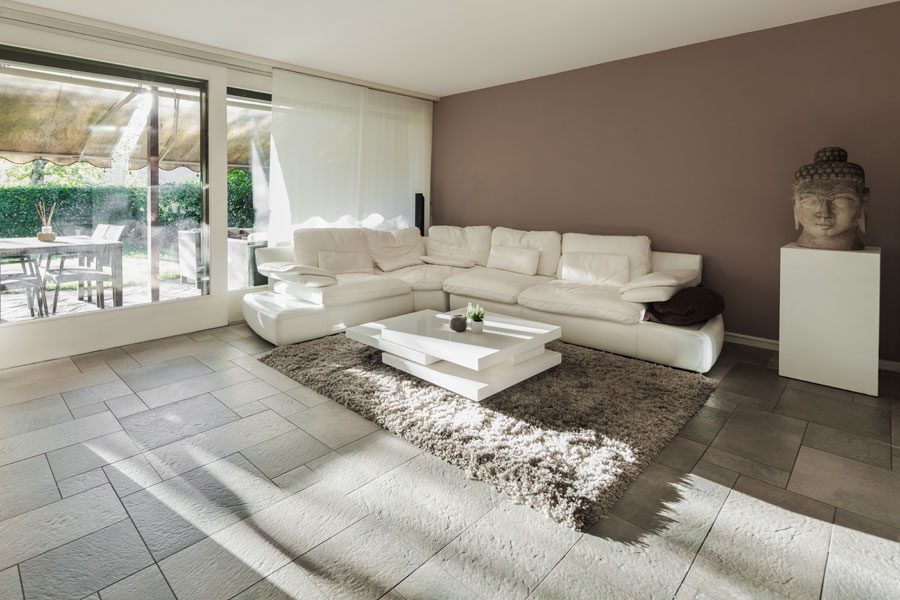Although natural stone has been used as a floor material for a long time, this material is not so common up here in the Nordic countries. The most likely cause is our cold climate. A stone floor made of natural stone pavers can feel cold and uncomfortable.
On good grounds, however, it can be expected that stone floors will become significantly more common in the future. This development is not least related to the modern technology that makes efficient underfloor heating possible.
With its rich variation in color, texture and surface treatment, the natural stone is strikingly adaptable as a stone floor covering. But the benefits do not only have to do with appearance. The wear resistance is also much better than for many other floor materials .

Long service life on stone floors
Although materials and installation costs may be higher than for other materials, this investment is offset by the significantly longer service life. It is not uncommon for the annual cost of a stone floor to be lower in the long run than for most other floor materials.
There are examples of marble floors in department store entrances that are in good condition after a full 60 years of daily wear, despite the fact that marble with normal wear values has been used.
Another advantage of natural stone is that individual tiles that have been subjected to extreme point wear, or damaged in other ways, are easy to replace without the rest of the stone floor requiring any re-arrangement or treatment.
The previously mentioned combination with underfloor heating makes the floor of natural stone particularly interesting. All natural stone pavers has a high heat capacity, which gives two very large advantages in homes. The floors become comfortable to walk on and water dries up quickly.
A lighter installation technique also speaks for stone floors. Traditionally, normally thick stone is laid in cement mortar, but more recent technology involves thin, evenly thick stones being laid in adhesive against a flat surface. This makes it possible to use natural stone even in so-called single-layer floors, where the structural concrete has a flat surface.
The material thus becomes useful even in villas, where it can often be difficult to adapt the surface to traditional laying. In homes, natural stone floors have so far been mostly used in entrances and halls. The technology with adhesive mass also opens up possibilities for laying in other spaces.
A living room with natural stone floors and robust textile rugs is not only effective in terms of appearance but also very easy to keep clean.
Five natural stones in the standard range
The selection of natural stone for indoor flooring is surprisingly large. Both domestic and foreign stone occur. Most products are imported goods. Many confuse each other.
Among the imported goods, many go under the name marble without being genuine marble for that reason. Among other things, several poleable limestone species appear in the same shape as marble.
In the large assortment, you can clearly distinguish five standard stones: marble, limestone, slate, hard sandstone and granite. The price of natural stone is very variable. There are floor stones for a few dog ralapps per square meter, but also those that cost several thousand in the same size.
Excessive slip risk with natural stone floors
A common perception is that sanded floors in natural stone are slippery. With its reflective surface, a polished floor also gives the impression of being slippery. However, most studies show the opposite.
If you still want a rougher surface, you can, for example, choose quartz seat sandstone or mica slate. Even a coarser sanded, planed or flamed surface provides a rougher surface.
The surface treatment is of great importance for the appearance of the floor. While a polished and finely ground surface emphasizes the color and structure of the material, coarser surface treatments, such as planing, make the color lighter and the texture less clear. However, it is not uncommon for even coarser surfaces to acquire a more saturated color over time.
No major cleaning problems
Coarse, unpolished surfaces can be more difficult to keep clean, especially if you clean by hand. If, on the other hand, you have the opportunity to use a scrubber, cleaning is problem-free.
The choice of color can have a certain significance for the cleaning. Dirt and footprints, for example, appear more clearly on solid dark or light surfaces than on stone surfaces with varying color and structure.
Some types of stone fade over time and can even become rough and slightly bumpy. However, these changes are almost always associated with such severe wear and tear that they do not cause any problems in normal housing.
Stone floors in many different formats
Floor stones are available in various formats, including square and rectangular tiles, which provides great opportunities for pattern laying. Slab and tile thicknesses often vary between 20-30 mm, but the stone tiles can also be evenly thick, 10 or 20 mm with a tolerance of 1 mm. The thickness within one and the same batch can thus vary within these limits.
In descending lengths, the following widths are usually in stock: marble and limestone – 100, 150, 200 and 300 mm; slate 150, 200, 250, 300, 350 and 400 mm. In addition, evenly thick 10 mm large slabs of many marble, limestone and granite varieties in the 200 × 400 mm format are kept, sometimes with the dimensions 150 × 300 mm.
One way to get a floor in natural stone is to buy older stone that has been preserved from a demolition. It is becoming more common to use old stone. Smaller companies or individuals are often responsible for this trade.